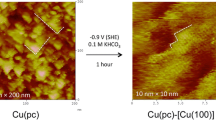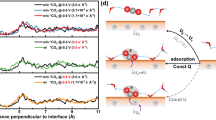Abstract
Exposing a Cu(100) electrode surface to an acidic and iodide containing electrolyte (5 mM H2SO4/1 mM KI) leads to the formation of an electro-compressible/electro-decompressible c(p × 2)-I adsorbate layer at potentials close to the onset of the copper dissolution reaction. An increase of mobile CuI monomers on-top of the iodide modified electrode surface causes the local CuI solubility product to be exceeded thereby giving rise to the nucleation and growth of a laterally well ordered 2D-CuI film at potentials below 3D-CuIbulk phase formation. Step edges serve as sources for the consumption of copper material upon compound formation leading to accelerated copper dissolution at the step edges. The 2D-CuI film exhibits symmetry properties and nearest neighbor spacings that are closely related to the (111) lattice of the crystalline CuIbulk phase. Intriguingly, the 2D-CuI film on Cu(100) does not act as an efficient passive layer. Copper dissolution proceeds at slightly higher potentials even in the presence of this binary 2D-compound via an inverse step flow mechanism. Further dissolution causes the nucleation and growth of 3D-CuI clusters on-top of the 2D-CuI film. This several nanometer thick 3D-CuIbulk phase passivates the electrode against further dissolution. Characteristically, the formation/dissolution of the 3D-CuIbulk phase reveals a significantly larger potential hysteresis of about ΔE = 320 mV while the appearance/disappearance of the 2D-CuI film is reversible with a potential hysteresis of only ΔE = 20 mV.
Similar content being viewed by others
References
Andriacos P.C., Uzoh C., Ducovic J.O., Horcans J., Deligianni H., (1998) IBM J. Res. Dev. 42: 567
Arnaud L., Tartavel G., Berger T., Mariolle D., Gobil Y., Touet I., (2000) Microelectron. Reliab. 40: 1295
Vogt M.R., Polewska W., Magnussen O.M., Behm R.J., (1997) J. Electrochem. Soc. 144: L113
Polewska W., Vogt M.R., Magnussen O.M., Behm R.J., (1999) J. Phys. Chem. B 103: 10440
Scherer J., Vogt M.R., Magnussen O.M., Behm R.J., (1997) Langmuir 13(26): 7045
Szocs E., Vastag G., Shaban A., Kalman E., (2005) Corr. Sci. 47: 893
Ikemiya N., Kubo T., Hara S., (1995) Surf. Sci. 323:81
Maurice V., Strehblow H.-H., Marcus P., (1999) J. Electrochem. Soc. 146: 524
Maurice V., Strehblow H.-H., Marcus P., (2000) Surf. Sci. 458: 185
Strehblow H.-H., Maurice V., Marcus P., (2001) Electrochim. Acta 46: 3755
Suggs D.W., Bard A.J., (1994) J. Am. Chem. Soc. 116: 10725
Suggs D.W., Bard A.J., (1995) J. Phys. Chem. 99: 8349
Vogt M.R., Lachenwitzer A., Magnussen O.M., Behm R.J., (1998) Surf. Sci. 399:49
Magnussen O.M., Vogt M.R., (2000) Phys. Rev. Lett. 85: 357
Magnussen O.M., Zitzler L., Gleich B., Vogt M.R., Behm R.J., (2001) Electrochim. Acta 46: 3725
Magnussen O.M., (2002) Chem. Rev. 102: 679
Broekmann P., Anastasescu M., Spaenig A., Lisowski W., Wandelt K., (2001) J. Electroanal. Chem. 500: 241
Kunze J., Maurice V., Klein L.H., Strehblow H.-H., Marcus P., (2003) J. Electroanal. Chem. 554–555: 113
Kunze J., Maurice V., Klein L.H., Strehblow H.-H., Marcus P., (2004) Corr. Sci. 46: 245
Wilms M., Kruft M., Bermes G., Wandelt K., (1999) Rev. Sci. Instr. 70(7): 3641
Broekmann P., Spaenig A., Hommes A., Wandelt K., (2002) Surf. Sci. 517(1–3): 123
P. Broekmann, A. Spaenig, A. Hommes and K. Wandelt (to be published)
Inukai J., Osawa Y., Itaya K., (1998) J. Phys. Chem. B. 102: 10034
Hommes A., Spaenig A., Broekmann P., Wandelt K., (2003) Surf. Sci. 547:239
P. Broekmann, S. Huemann, H. Zajonz, R. Hunger and K. Wandelt (to be published)
Andryushechkin B.V., Eltsov K.N., Shevlyuga V.M., Bardi U., Cortigiani B., (2002) Surf. Sci. 497: 59
Andryushechkin B.V., Eltsov K.N., Shevlyuga V.M., (2004) Surf. Sci. 566–568: 203
Mattson E., Bockris J.O., (1959) Trans. Faraday. Soc. 55: 1586
Bertocci U., (1966) Electrochim. Acta 11: 1261
Bertocci U., Turner D.R., (1974) In: Bard A.J. (eds) Encyclopedia of Electrochemistry of the Elements, Vol III. Marcel Dekker, New York, pp. 383
Wong D.Y., Coller B.A.W., MacFarlane D.R., (1993) Electrochim. Acta 38: 2121
De Agostini A., Schmidt E., Lorenz W.J., (1989) Electrochim. Acta 34: 1243
Irish D.E., Stolberg L., Shoesmith D.W., (1985) Surf. Sci. 158: 238
Hollemann-Wiberg, Lehrbuch der Anorganischen Chemie, deGruyter (1995)
Dobelhofer K., Wasle S., Soares D.M., Weil K.G., Weinberg G., Ertl G., (2003) Z. Phys. Chem. 217: 479
Broekmann P., Wilms M., Kruft M., Stuhlmann C., Wandelt K., (1999) J. Electroanal. Chem. 467: 307
Giesen M., Baier S., (2001) J. Phys.: Cond. Matter. 13:5009
Giesen M., (2001) Prog. Surf. Sci. 68: 1
S. Ye and K. Uosaki. in A.J. Bard and M. Stratmann (eds), Encyclopedia of Electrochemistry, Volume 1: Thermodynamics and Electrified Interfaces (Wiley-VCH, 2001)
Gregory B.W., Stickney J.L., (1991) Electroanal. Chem. 300: 543
J.L. Stickney, T.L. Wade, B.H. Flowers, R. Vaidyanathan and U. Happek. in A.J. Bard and M. Stratmann (eds), Encyclopedia of Electrochemistry Volume 1: Thermodynamics and Electrified Interfaces. (Wiley-VCH, 2001)
Adzic R.R., Wang J.X., (1998) J. Phys. Chem. B 102: 6307
Author information
Authors and Affiliations
Corresponding author
Rights and permissions
About this article
Cite this article
Broekmann, P., Hai, N.T.M. & Wandelt, K. Copper dissolution in the presence of a binary 2D-compound: CuI on Cu(100). J Appl Electrochem 36, 1241–1252 (2006). https://doi.org/10.1007/s10800-006-9183-2
Received:
Accepted:
Published:
Issue Date:
DOI: https://doi.org/10.1007/s10800-006-9183-2




